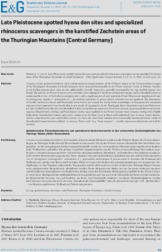Late Pleistocene spotted hyena den sites and specialized rhinoceros scavengers in the karstified Zechstein areas of the Thuringian Mountains (Central Germany)
Diedrich, Cajus
Diedrich, Cajus, 2015: Late Pleistocene spotted hyena den sites and specialized rhinoceros scavengers in the karstified Zechstein areas of the Thuringian Mountains (Central Germany). In: E&G – Quaternary Science Journal; Vol.64, No.1, p.29-45, DOI: 10.3285/eg.64.1.03.
 |
Dokument öffnen: |
Crocuta crocuta spelaea (Goldfuss 1823) cranial and postcranial remains of the Pößneck region in the Zechstein Karst region of the Thuringian Mountains (Central Germany) were excavated historically in the Wüste Scheuer Cavity at Döbritz. Nearby, at the Krölpa gypsum karst open air site, additionally a woolly rhinoceros, partially scavenged by Ice Age spotted hyenas, was found. The amount at Wüste Scheuer Cavity includes chew damaged Coelodonta antiquitatis remains and is classified herein as communal den type. At both den/scavenging sites, only a small amount of prey material of Late Pleistocene megafauna of rare M. primigenius, mainly C. antiquitatis, E. c. przewalskii, and fewer B. priscus and R. tarandus was accumulated. The dominance of woolly rhinoceros, bison and Przewalski horse bones are typical for hyena bone assemblages in European low mountain regions, where mammoth was nearly absent as a result of topography. In the Thuringian Karst Mountains nine Late Pleistocene Ice Age spotted hyena den sites are identified. Solely hyena dens are present in Zechstein open air gypsum and limestone karstic regions of Bad Köstritz, Krölpa and Fuchsluken Cavities near Saalfeld. In the Wüste Scheuer their remains overlap with Middle Palaeolithic Neanderthal human camp sites, similar as in the Ilsen Cave at Ranis and Lindenthal Cave in Gera, which demonstrates competition for prey and shelter cavities. At such cave sites, bone remains were historically misinterpreted as „solely of Neanderthal human kitchen rubbish” or even as “bone tools” (e.g. “bone scrapers” = woolly rhinoceros tibia bones chewed by hyenas).

